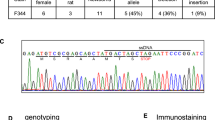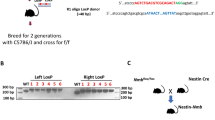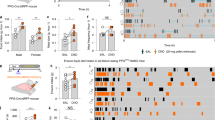Abstract
Background:
Neuromedin U (NMU) is a neuropeptide with various physiological functions, including regulation of smooth-muscle contraction, blood pressure, stress responses and feeding behaviors. NMU activates two distinct receptors, NMUR1 and NMUR2, which are predominantly expressed in peripheral tissues and the central nervous system (CNS), respectively. It is reported that the NMU signaling system regulates food intake (FI) and body weight (BW) via NMUR2, suggesting that an NMUR2 agonist exhibiting anorectic effects would be a potential therapy for obesity.
Methods:
Antiobesity effects of NMUR2 activation were assessed using a recently developed, novel NMUR2-selective agonist, NMU-7005 (a polyethylene glycolated octapeptide). Here we assessed cumulative FI and BW loss after peripheral administration of NMU-7005 in NMUR2 knockout and diet-induced obese mice. To gain mechanistic insights, we performed immunohistochemical analysis of c-Fos-like protein expression in the brain.
Results:
We found that NMU-7005 was a NMUR2-selective agonist with little activity toward NMUR1. The anorectic effect of NMU-7005 was completely abrogated in NMUR2 knockout mice. Repeated subcutaneous administration of NMU-7005 showed a potent antiobesity effect with FI inhibition (P<0.025) in diet-induced obese mice. NMU-7005 in combination with the glucagon-like peptide-1 receptor (GLP-1R) agonist liraglutide showed an additive antiobesity effect, suggesting that NMUR2-mediated anorectic action is different from that of GLP-1R agonists. NMU-7005 also elicited a minimal conditioned taste-aversive effect, while the effect of liraglutide was significant. As c-Fos expression was upregulated in the hypothalamus and the medulla oblongata in NMU-7005-administered mice, the pharmacological effects of NMU-7005 appeared to be mediated via activation of the CNS.
Conclusion:
Our results demonstrated that a novel NMUR2-selective agonist, NMU-7005, is a beneficial tool for the elucidation of NMUR2-mediated physiological functions, which is a promising therapeutic strategy for treating obesity.
This is a preview of subscription content, access via your institution
Access options
Subscribe to this journal
Receive 12 print issues and online access
$259.00 per year
only $21.58 per issue
Buy this article
- Purchase on Springer Link
- Instant access to full article PDF
Prices may be subject to local taxes which are calculated during checkout





Similar content being viewed by others
References
Ng M, Fleming T, Robinson M, Thomson B, Graetz N, Margono C et al. Global, regional, and national prevalence of overweight and obesity in children and adults during 1980–2013: a systematic analysis for the Global Burden of Disease Study 2013. Lancet 2014; 384: 766–781.
Daneschvar HL, Aronson MD, Smetana GW . FDA-approved anti-obesity drugs in the United States. Am J Med 2016; 129: 879.e1–879.e6.
Minamino N, Kangawa K, Matsuo H . Neuromedin U-8 and U-25: novel uterus stimulating and hypertensive peptides identified in porcine spinal cord. Biochem Biophys Res Commun 1985; 130: 1078–1085.
Brighton PJ, Szekeres PG, Willars GB . Neuromedin U and its receptors: structure, function, and physiological roles. Pharmacol Rev 2004; 56: 231–248.
Mitchell JD, Maguire JJ, Davenport AP . Emerging pharmacology and physiology of neuromedin U and the structurally related peptide neuromedin S. Br J Pharmacol 2009; 158: 87–103.
Martinez VG, O’Driscoll L, Neuromedin U . A multifunctional neuropeptide with pleiotropic roles. Clin Chem 2015; 61: 471–482.
Fujii R, Hosoya M, Fukusumi S, Kawamata Y, Habata Y, Hinuma S et al. Identification of neuromedin U as the cognate ligand of the orphan G protein-coupled receptor FM-3. J Biol Chem 2000; 275: 21068–21074.
Hosoya M, Moriya T, Kawamata Y, Ohkubo S, Fujii R, Matsui H et al. Identification and functional characterization of a novel subtype of neuromedin U receptor. J Biol Chem 2000; 275: 29528–29532.
Howard AD, Wang R, Pong SS, Mellin TN, Strack A, Guan XM et al. Identification of receptors for neuromedin U and its role in feeding. Nature 2000; 406: 70–74.
Raddatz R, Wilson AE, Artymyshyn R, Bonini JA, Borowsky B, Boteju LW et al. Identification and characterization of two neuromedin U receptors differentially expressed in peripheral tissues and the central nervous system. J Biol Chem 2000; 275: 32452–32459.
Shan L, Qiao X, Crona JH, Behan J, Wang S, Laz T et al. Identification of a novel neuromedin U receptor subtype expressed in the central nervous system. J Biol Chem 2000; 275: 39482–39486.
Graham ES, Turnbull Y, Fotheringham P, Nilaweera K, Mercer JG, Morgan PJ et al. Neuromedin U and Neuromedin U receptor-2 expression in the mouse and rat hypothalamus: effects of nutritional status. J Neurochem 2003; 87: 1165–1173.
Kojima M, Haruno R, Nakazato M, Date Y, Murakami N, Hanada R et al. Purification and identification of neuromedin U as an endogenous ligand for an orphan receptor GPR66 (FM3). Biochem Biophys Res Commun 2000; 276: 435–438.
Nakazato M, Hanada R, Murakami N, Date Y, Mondal MS, Kojima M et al. Central effects of neuromedin U in the regulation of energy homeostasis. Biochem Biophys Res Commun 2000; 277: 191–194.
Peier AM, Desai K, Hubert J, Du X, Yang L, Qian Y et al. Effects of peripherally administered neuromedin U on energy and glucose homeostasis. Endocrinology 2011; 152: 2644–2654.
Kowalski TJ, Spar BD, Markowitz L, Maguire M, Golovko A, Yang S et al. Transgenic overexpression of neuromedin U promotes leanness and hypophagia in mice. J Endocrinol 2005; 185: 151–164.
Hanada R, Teranishi H, Pearson JT, Kurokawa M, Hosoda H, Fukushima N et al. Neuromedin U has a novel anorexigenic effect independent of the leptin signaling pathway. Nat Med 2004; 10: 1067–1073.
Hainerová I, Torekov SS, Ek J, Finková M, Borch-Johnsen K, Jørgensen T et al. Association between neuromedin U gene variants and overweight and obesity. J Clin Endocrinol Metab 2006; 91: 5057–5063.
Mori K, Miyazato M, Ida T, Murakami N, Serino R, Ueta Y et al. Identification of neuromedin S and its possible role in the mammalian circadian oscillator system. EMBO J 2005; 24: 325–335.
Ida T, Mori K, Miyazato M, Egi Y, Abe S, Nakahara K et al. Neuromedin s is a novel anorexigenic hormone. Endocrinology 2005; 146: 4217–4223.
Niimi M, Murao K, Taminato T . Central administration of neuromedin U activates neurons in ventrobasal hypothalamus and brainstem. Endocrinology 2001; 16: 201–206.
Benzon CR, Johnson SB, McCue DL, Li D, Green TA, Hommel JD . Neuromedin U receptor 2 knockdown in the paraventricular nucleus modifies behavioral responses to obesogenic high-fat food and leads to increased body weight. Neuroscience 2014; 258: 270–279.
Kanematsu-Yamaki Y, Nishizawa N, Kaisho T, Nagai H, Mochida T, Asakawa T et al. Potent body weight-lowering effect of a neuromedin U receptor 2-selective PEGylated peptide. J Med Chem 2017; 60: 6089–6097.
Moritoh Y, Takeuchi K, Hazama M . Combination treatment with alogliptin and voglibose increases active GLP-1 circulation, prevents the development of diabetes and preserves pancreatic beta-cells in prediabetic db/db mice. Diabetes Obes Metab 2010; 12: 224–233.
Ingallinella P, Peier AM, Pocai A, Marco AD, Desai K, Zytko K et al. PEGylation of Neuromedin U yields a promising candidate for the treatment of obesity and diabetes. Bioorg Med Chem 2012; 20: 4751–4759.
Neuner P, Peier AM, Talamo F, Ingallinella P, Lahm A, Barbato G et al. Development of a neuromedin U-human serum albumin conjugate as a long-acting candidate for the treatment of obesity and diabetes. Comparison with the PEGylated peptide. J Pept Sci 2014; 20: 7–19.
Micewicz ED, Bahattab OS, Willars GB, Waring AJ, Navab M, Whitelegge JP et al. Small lipidated anti-obesity compounds derived from neuromedin U. Eur J Med Chem 2015; 101: 616–626.
Peier A, Kosinski J, Cox-York K, Qian Y, Desai K, Feng Y et al. The antiobesity effects of centrally administered neuromedin U and neuromedin S are mediated predominantly by the neuromedin U receptor 2 (NMUR2). Endocrinology 2009; 150: 3101–3109.
Frayn KN . Visceral fat and insulin resistance – causative or correlative? Br J Nutr 2000; 83 (Suppl 1): S71–S77.
Halatchev IG, Cone RD . Peripheral administration of PYY (3-36) produces conditioned taste aversion in mice. Cell Metab 2005; 1: 159–168.
Chelikani PK, Haver AC, Reidelberger RD . Dose-dependent effects of peptide YY (3-36) on conditioned taste aversion in rats. Peptides 2006; 27: 3193–3201.
Liang NC, Bello NT, Moran TH . Additive feeding inhibitory and aversive effects of naltrexone and exendin-4 combinations. Int J Obes 2013; 37: 272–278.
Hahn TM, Breininger JF, Baskin DG, Schwartz MW . Coexpression of Agrp and NPY in fasting-activated hypothalamic neurons. Nat Neurosci 1998; 1: 271–272.
Gartlon J, Szekeres P, Pullen M, Sarau HM, Aiyar N, Shabon U et al. Localisation of NMU1R and NMU2R in human and rat central nervous system and effects of neuromedin-U following central administration in rats. Psychopharmacology 2004; 177: 1–14.
Miller AD, Leslie RA . The area postrema and vomiting. Front Neuroendocrinol 1994; 15: 301–320.
Stoicea N, Gan TJ, Joseph N, Uribe A, Pandya J, Dalal R et al. Alternative therapies for the prevention of postoperative nausea and vomiting. Front Med 2015; 2: 87.
Broadwell RD, Brightman MW . Entry of peroxidase into neurons of the central and peripheral nervous systems from extracerebral and cerebral blood. J Comp Neurol 1976; 166: 257–283.
Suzuki K, Jayasena CN, Bloom SR . Obesity and appetite control. Exp Diabetes Res 2012; 2012: 824305.
Secher A, Jelsing J, Baquero AF, Hecksher-Sørensen J, Cowley MA, Dalbøge LS et al. The arcuate nucleus mediates GLP-1 receptor agonist liraglutide-dependent weight loss. J Clin Invest 2014; 124: 4473–4488.
Acknowledgements
We thank Dr Masakuni Noda and Dr Yukio Yamada for discussions and encouragement throughout this study. We also thank Editage (http://www.editage.jp) for English language editing. The study was supported by Takeda Pharmaceutical Compny Limited.
Author information
Authors and Affiliations
Corresponding author
Ethics declarations
Competing interests
The authors are/were employees of Takeda Pharmaceutical Company Limited.
Additional information
Supplementary Information accompanies this paper on International Journal of Obesity website
Rights and permissions
About this article
Cite this article
Kaisho, T., Nagai, H., Asakawa, T. et al. Effects of peripheral administration of a Neuromedin U receptor 2-selective agonist on food intake and body weight in obese mice. Int J Obes 41, 1790–1797 (2017). https://doi.org/10.1038/ijo.2017.176
Received:
Revised:
Accepted:
Published:
Issue Date:
DOI: https://doi.org/10.1038/ijo.2017.176



